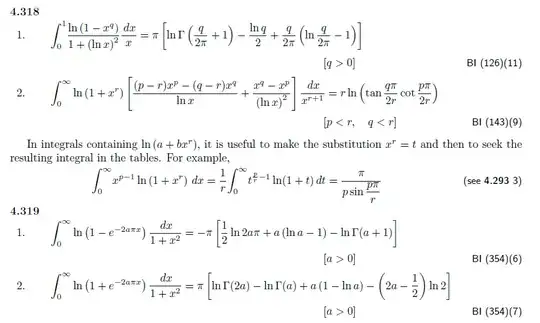Similar to the evaluation of $\int_{0}^{\infty} \operatorname{Li}_{2}(e^{-\pi x}) \arctan(x) \, \mathrm dx$ here, we have $$ \begin{align} \int_{0}^{\infty} \frac{\ln(1-e^{-\pi x})}{1+x^{2}} \, \mathrm dx &= -\int_{0}^{\infty} \frac{1}{1+x^{2}} \sum_{n=1}^{\infty} \frac{e^{- \pi n x}}{n} \, \mathrm dx\\ &= -\sum_{n=1}^{\infty} \frac{1}{n} \int_{0}^{\infty} \frac{e^{- \pi n x}}{1+x^{2}} \, \mathrm dx \\ &= - \sum_{n=1}^{\infty} \frac{1}{n} \left( \left(\frac{\pi}{2} - \operatorname{Si}(\pi n) \right) \cos(\pi n) + \operatorname{Ci}(\pi n ) \sin(\pi n ) \right) \\ &= \frac{\pi}{2}\sum_{n=1}^{\infty} \frac{(-1)^{n+1}}{n} + \sum_{n=1}^{\infty} (-1)^{n} \frac{\operatorname{Si}(\pi n)}{n} \\ &= \frac{\pi}{2} \ln(2) + \sum_{n=1}^{\infty} (-1)^{n} \frac{\operatorname{Si}(\pi n)}{n}, \end{align}$$
where $\operatorname{Si}(z)$ is the sine integral and $\operatorname{Ci}(z)$ is the cosine integral.
To show that $$\sum_{n=1}^{\infty} (-1)^{n} \frac{\operatorname{Si}(\pi n)}{n} = - \frac{\pi}{2}, $$ we can integrate the meromorphic function $$f(z) = \frac{\pi \csc(\pi z) \operatorname{Si}(\pi z)}{z}$$ around a rectangular contour with vertices at $z= \pm \left(N+ \frac{1}{2} \right) \pm i\left(N+ \frac{1}{2} \right),$ where $N$ is a positive integer.
Using the asymptotic expansion of $\operatorname{Si}(z)$, we have $$ \small f(z) \sim \frac{\pi \csc(\pi z) \left(\frac{\pi}{2}+ \cos(\pi z) \, O \left(\frac{1}{z} \right) + \sin(\pi z) \, O \left(\frac{1}{z^{2}} \right) \right) }{z} = \frac{\pi^{2} \csc(\pi z)}{2z} + \cot(\pi z) \, O \left(\frac{1}{z^{2}} \right) + O \left(\frac{1}{z^{3}} \right)$$ as $|z| \to \infty$ in the sector $|\arg(z) | \le \pi - \delta, \ \delta >0$.
It might seem that the first term of the asymptotic expansion would prevent the integral from vanishing as $N \to \infty$, but it actually doesn't. See the answers to this question.
So we have $$ \begin{align} 0 &= 2 \pi i \sum_{n=-\infty}^{\infty}\operatorname{Res}[f(z), n] \\ &= 2 \pi i \left( \sum_{n=-\infty}^{-1} (-1)^{n} \frac{\operatorname{Si}(\pi n)}{n} + \pi + \sum_{n=1}^{\infty} (-1)^{n} \frac{\operatorname{Si}(\pi n)}{n} \right) \\ &= 2 \pi i \left(2 \sum_{n=1}^{\infty} (-1)^{n} \frac{\operatorname{Si}(\pi n)}{n} + \pi \right), \end{align}$$ and the result follows.

